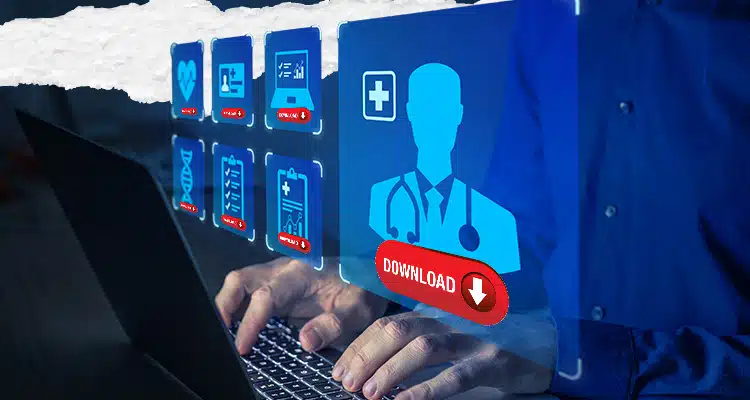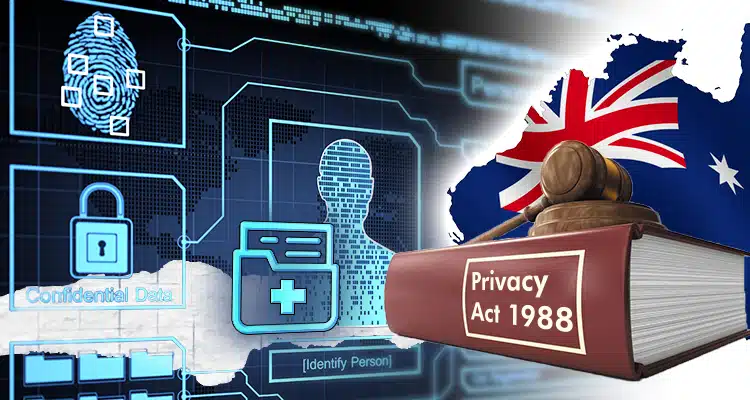Contents
-
- Addressing the Challenges and Opportunities of Digital Transformation in Australian Healthcare
- Healthcare IT Infrastructure in Australia: Balancing Reliability and Security
- Ultimate Guide to Electronic Health Records (EHRs) Management for Businesses in Australia
-
-
- What Are EHRs?
- EHRs in Australia: A Background
- Legal and Regulatory Considerations
- The Future of EHRs in Australia
- Choosing the Right EHR System for Your Business (If You’re a Healthcare Provider)
- Implementing and Managing Your EHR System
- EHR Use and Optimisation Strategies
- Moving Forward
- Additional Resources
-
-
- Ethical Considerations in AU Healthcare Technology: Balancing Innovation with Patient Privacy and Safety
Addressing the Challenges and Opportunities of Digital Transformation in Australian Healthcare
Digital transformation has not spared the healthcare sector, bringing with it opportunities and challenges, particularly in Australia.It also promises to revolutionise patient care, enhance clinical decision-making, and streamline operations.
However, this transformation comes with its set of challenges. Concerns around data security and digital equity to prevent widening the health access gap are at the forefront. Addressing these concerns is important for realising the full potential of digital transformation in healthcare.
Globally, healthcare is also undergoing a significant digital transformation, reshaping patient care and operational efficiency.
In Australia, the adoption of digital health technologies is gaining momentum, driven by the need to improve healthcare delivery and patient outcomes.
Challenges of Digital Transformation in Australian Healthcare
While the digital transformation in Australian healthcare opens many opportunities, it also raises several challenges that need careful consideration:
1. Data security and privacy concerns.
The digitalisation of healthcare raises significant data security and privacy concerns. Integrating digital tech in healthcare requires staff training on data privacy to combat cyber threats, while collaboration is essential for digital health solutions that comply with data protection standards.Robust cybersecurity measures and clear data governance frameworks are essential to protect sensitive patient information, in line with the Privacy Act 1988 and HIPAA guidelines.The Privacy Act 1988 in Australia outlines standards for managing personal information and securing data protection across sectors, including healthcare.While HIPAA is within the US’ jurisdiction for medical data security, its principles influence Australia’s stringent healthcare data protection standards.
2. Interoperability and integration issues.
The Australian healthcare system faces challenges with incomplete IT systems and the need for standardised data formats and interoperable platforms. The lack of interoperability can lead to fragmented patient records and inefficiencies in healthcare delivery. Addressing these issues requires collaboration across healthcare providers and technology developers. This approach should guarantee a seamless exchange of information and continuity of care. It will enhance patient outcomes and support healthcare professionals in making informed decisions while reducing administrative burdens for more focused patient care.
3. Digital equity and access disparities.
There is a risk that digital transformation could widen existing healthcare access disparities. The move toward digital healthcare may leave behind those in remote or underprivileged areas lacking technology access. It’s vital to address this by providing all Australians with the necessary tools and connectivity. Strategies to bridge the digital divide are essential to make digital health services more accessible. Implementing telehealth services and online resources can play a significant role in overcoming geographical barriers. Additionally, providing digital literacy training can empower individuals to use these digital health services effectively.
Australian-Specific Considerations
Government initiatives like My Health Record are pivotal to promoting digital healthcare across Australia. These initiatives facilitate the secure and efficient sharing of health information, enhancing care coordination and patient outcomes. They also support the move towards a more integrated healthcare system, bridging gaps between different healthcare services.
However, the country’s vast geography and diverse healthcare providers present unique challenges and opportunities for digital health implementation. It requires innovative solutions to guarantee equitable access to digital health services for all Australians, regardless of location. Tailored approaches are necessary to accommodate the varied needs of urban, rural, and remote communities so no one is left behind in the digital health transition.
Opportunities of Digital Transformation in Australian Healthcare
Australia’s healthcare system is on the cusp of a major transformation driven by digital innovation. From remote consultations to powerful analytics, a range of new technologies are emerging that hold immense potential. These advancements have the power to improve patient experiences, streamline healthcare delivery, and equip Australians with the tools to manage their own well-being. By pushing for the potential of digital health, Australia can build more accessible, efficient, and patient-centred healthcare systems that will be impactful to its citizens.
The Road Ahead
Addressing the challenges of digital transformation in Australian healthcare requires:
1. Innovative Solutions.
Developing new technologies and applications that enhance patient care and streamline operations, focusing on user-friendly designs that allow wide adoption and effectiveness.
2. Best Practices.
Learning from successful digital health implementations both within Australia and internationally, adopting standards that ensure data security, interoperability, and patient privacy.
3. Collaborative Approach Among Stakeholders.
Engaging healthcare providers, technology developers, patients, and policymakers in the design and implementation of digital health solutions to meet the needs of all parties involved.
Continuous Education and Training. Providing ongoing education for healthcare professionals on the latest digital tools and technologies.
4. Public Awareness and Engagement.
Raising awareness about the benefits of digital health services among the general public to increase acceptance and usage.
5. Regulatory Support and Adaptation.
Regulations should keep pace with technological advancements, facilitating innovation while safeguarding patient interests and data security.
The current outlook is promising, with digital health poised to play an important role in enhancing healthcare delivery in Australia.
Conclusion
Digital transformation in Australian healthcare offers immense potential to:
-
- Improve patient care
- Enhance efficiency
- Address longstanding challenges
- Reduce healthcare disparities
- Increase access to specialist services
- Foster innovation in treatment and diagnosis
- Streamline patient data management
- Promote patient engagement and self-management
- Support public health monitoring and response
Moving towards digital change is very important for Australia’s healthcare system in the future because it creates a more welcoming, organized, and creative environment. By using technology well, we can guarantee all Australians the best possible care no matter where they live or what their backgrounds are. This journey towards digital healthcare is to adopt new tools and improve health and well-being across the nation.
Unlocking this potential hinges on an effective and efficient support manpower system. Skilled professionals are also needed to provide their expertise and services in support of both healthcare and digital technologies. This includes roles like digital health specialists, data analysts, and cybersecurity experts. By building a robust support system, Australia can fast-track its roadmap to excellent digital healthcare transformation.
Healthcare IT Infrastructure in Australia: Balancing Reliability and Security
Modern patient care goes beyond treating illnesses. It also focuses on a patient-centered approach, emphasizing communication, preventive measures, and technology.
This is where healthcare IT infrastructure comes in.
Reliable and secure IT systems provide Australians with access to telehealth and electronic health records, vastly improving patient care.
The AU healthcare system is one of the best in the world. However, it also has its challenges due to geographical dispersion, cybersecurity threats, and an ageing medical workforce.
If so, how can healthcare IT infrastructure help?
The Importance of Reliability
A reliable healthcare IT infrastructure is the backbone of modern patient care, ensuring smooth operation, safeguarding sensitive data, and improving patient outcomes.
Medical decisions often rely on data and equipment functioning flawlessly. A system crash during surgeries or errors in patient records could lead to life-and-death consequences.
Thus, reliable IT infrastructure helps healthcare providers make informed decisions based on accurate information. Otherwise, IT issues disrupt workflows and delay treatments.
Consequences of System Downtime
Conversely, system failure can lead to potential problems and severe consequences in the Australian healthcare industry, such as:
-
-
-
- Delays in treatment decisions;
- Errors in medical records;
- Disruption of critical services;
- Compromised care quality;
- Reputational damaged; and
- Cybersecurity threats.
-
-
The Threat Landscape: Security Concerns in Australian Healthcare
Despite its world-class healthcare system, Australia continues to face security concerns due to a combination of factors.
Data Breaches and Cyberattacks.
The Australian healthcare sector is a prime target for cybercriminals given its vast database of sensitive information. In 2019, for instance, Australia’s My Health Record system saw a rise in data breaches. Hence, the AU healthcare industry must provide safeguards to address:
-
-
-
- Increasing incidents of unauthorised access to patient data;
- Vulnerability of interconnected medical devices; and
- Targeting of Australian healthcare institutions by cyber criminals.
-
-
Regulatory Compliance.
Despite its advanced healthcare system, Australia continues to face various challenges when it comes to regulatory compliance.
In 2019, Victoria University published a paper reviewing Australia’s health service arrangements. According to the study, the AU healthcare system is complex, with its current arrangement being a major impediment to improving patient experience, health outcomes, and compliance. Compliance issues in AU healthcare usually involve:
-
-
-
- Failure to comply with reporting requirements when there are hospital-acquired infections or data breaches;
- Improper use of Telehealth services related to patient consent, privacy, and data security;
- Inadequate staffing levels for the Aged Care Quality and Safety Commission;
- Medication errors or inadequate monitoring of potential drug interactions; and
- Excessive billing such as overcharging or submitting claims for unnecessary services.
-
-
Impact on Patient Care.
A good healthcare IT infrastructure enables:
-
-
-
- Timely access to accurate medical records for diagnosis and treatment;
- Streamlined communication and collaboration among healthcare providers;
- Efficient operation of medical devices and equipment;
- Reduced administrative burden on staff;
- Secured access to test results and appointment summaries;
- Reduced risk of duplicate tests;
- Improved remote patient monitoring tools; and
- Prediction of potential health risks through analytics tools.
-
-
Ensuring System Reliability
A reliable healthcare IT infrastructure is the foundation of safe, effective, and efficient patient care.
Medical decisions are often based on available data and critical patient records. Therefore, any delay in retrieving information due to system outages or malfunctions can put patients at risk.
In addition, frequent outages can lead to workarounds that can compromise patient care. A reliable healthcare system fosters a culture of efficiency and safety. Otherwise, it could erode patient trust, damaging the healthcare institution’s reputation.
1. Hardware and Software Considerations.
Both hardware and software components require careful consideration when building a reliable healthcare IT infrastructure. Robust hardware prevents medical devices from malfunctioning, minimising errors during procedure, treatment plans, and diagnoses. On the other hand, scalable software allows for future growth without incurring significant additional costs in case of upgrades. Simply put, reliable hardware reduces downtime caused by equipment failure, while integrated software improves overall system reliability. To do both, AU healthcare providers can:
- Invest in robust and scalable IT infrastructure;
- Conduct regular maintenance and patching of systems;
- Implement redundancy measures like backup servers and disaster recovery plans;
- Regularly audit your software to identify outdated versions;
- Encourage the use of new software through training and support; and
- Dedicate sufficient resources for hardware upgrades and software licensing.
2. Operational Best Practices.
Having top-notch hardware and software isn’t enough to guarantee a smooth healthcare IT system. There’s still a need to implement best operational practices for a reliable, secure, and efficient system which include:
- Standardised processes for data entry and system usage;
- User training on cybersecurity threats and proper data handling;
- Proactive monitoring and performance analysis;
- Multi-factor authentication;
- Regular security audits to identify and address IT vulnerabilities; and
- Compliance with all relevant regulations to avoid legal repercussions.
Strategies for Enhancing Security
A robust and secure healthcare IT infrastructure is the bedrock of data integrity, protecting patient safety.
Healthcare organisations are entrusted with a vast amount of patient data, which requires strong security measures to protect privacy and sensitive information. Security strategies help mitigate the risks of cyberattacks, preventing data breaches, costly downtime, and potential lawsuits.
By implementing these robust security strategies, healthcare organisations can focus on their core mission of delivering exceptional patient care.
1. Data Encryption and Access Controls.
Data encryption protects patient data while access controls restrict access to authorised personnel. Both are necessary to safeguard sensitive patient information.
With the increasing number of security threats, AU healthcare providers can:
- Utilise strong encryption methods for patient data at rest and in transit;
- Implement granular access controls based on user roles and responsibilities;
- Create multi-factor authentication for secure login;
- Prioritise encrypting highly sensitive patient data;
- Limit access to patient data among selected and relevant staff; and
- Regularly review and update access privileges to authorised personnel.
2. Cybersecurity Awareness and Training.
Anyone who operates under the Australian healthcare industry should consider cybersecurity awareness as a fundamental part of its operations.
- Educate healthcare staff on cyber threats and phishing scams;
- Encourage a culture of data security within healthcare organisations;
- Develop training programs specifically for physicians, nurses, IT, and admin staff;
- Establish clear and user-friendly channels to report potential security breaches; and
- Track the effectiveness of the training programs through regular assessments.
The Role of Government and Industry in Strengthening the AU IT Healthcare Infrastructure
The AU government and the healthcare industry play essential roles in establishing a reliable and secure healthcare IT infrastructure. The government can establish a national framework setting standards for data security across all healthcare institutions in the country.
Meanwhile, industry players such as healthcare institutions and IT vendors can leverage shared expertise and resources to drive innovation.
A collaborative effort between the government and industry is essential to strengthen Australia’s overall healthcare IT infrastructure.
1. Government Initiatives.
The Australian government established policies and programs supporting health technologies and digital health capabilities. Government-funded telehealth initiatives promote geographic equity in healthcare delivery, especially for those in rural or remote areas.
For instance, AU’s My Health Record provides a centralised platform for healthcare providers to access a patient’s medical history, improving care coordination and treatment decisions.
In addition, there are also:
- Policies and funding to support the development of secure and reliable healthcare IT infrastructure;
- Collaboration with industry to address emerging cybersecurity threats;
- Funding initiatives offering grants to support biomedical technologies;
- Long-term plans for integrating digital health solutions into the healthcare system; and
- Collaboration with research institutions to develop new digital health solutions.
2. Industry Collaboration and Innovation.
There’s also a need to touch base with industry partners, enabling collaboration and innovation of healthcare technologies, such as:
- Sharing best practices for data security and incident response;
- Developing secure and interoperable healthcare IT systems;
- Partnering with technology companies and research institutions;
- Investing in AU health tech startups; and
- Providing a platform for connecting providers, patients, and healthcare applications.
Conclusion
Striking a balance between robust healthcare IT infrastructure and robust security measures is paramount for Australia’s digital health roadmap.
While telehealth and electronic health records offer a glimpse into a future of accessible and preventative care, these advancements necessitate a watertight IT infrastructure. This includes not only impenetrable cybersecurity protocols but also a workforce equipped to manage and maintain them.
By prioritizing both reliability and security, Australia can ensure its digital healthcare transformation empowers patients, safeguards sensitive information, and ushers in a new era of high-quality medical care for all its citizens.
Aside from strengthening their IT systems, healthcare providers can invest in the latest technology, skilled manpower, exert vigilance, and foster collaboration with government and industry partners.
By balancing reliability and security, Aussies can expect a healthcare system that empowers patients, improves care coordination, and delivers better health outcomes for all.
Ultimate Guide to Electronic Health Records (EHRs) Management for Businesses in Australia
Almost everything is digital nowadays.
More and more industries are employing new technologies and tools that aim to streamline business processes.
The healthcare industry is no exception.
For one, electronic health records (EHRs) are a primary example of how digitalisation has taken hold of the industry.
What Are EHRs?
As the name suggests, Electronic Health Records (ERHs) are digitised copies of patients’ health records.
These records contain relevant information such as demographics, progress notes, and medication, to mention a few.
Many healthcare providers rely on EHRs to immediately access a patient’s files and to provide the right treatment plan.
However, many healthcare organisations face a massive issue, and that is the vast amount of data that needs to be encoded.
In the Australian context, that means digitalising around 25 million people’s information—which is quite a tall order.
So, what can be done?
EHRs in Australia: A Background
Back in 2009, Australia’s National Health and Hospitals Reform Commission cited in a report that every Australian citizen should have control over access to their electronic health records.
Thus, the Australian government funded the development of Personally-Controlled Electronic Health Record (PCEHR) with $467 million in 2010.
However, the system went through a “rebranding” in 2015 and is now known as “My Health Records”—which Australian citizens can also choose to opt out of.
The Australian Institute of Health and Welfare (AIHW) was then appointed as the Data Custodian.
AIHW will be in charge of managing the use of the My Health Records system for research and public health purposes while upholding the security and privacy of such data.
Legal and Regulatory Considerations
Dealing with personal health information requires the utmost confidentiality.
Thus, Australia has several laws in place to safeguard everyone’s data in the healthcare industry, especially with the government and various industries pushing for digitalisation.
One of the legislations surrounding EHRs is the My Health Records Act 2012, which exists simultaneously with Australia’s Privacy Act and the Australian Privacy Principles (APP).
Each of these laws governs different types of information about an individual, some of which are highly sensitive and personal.
The type of privacy and protection given to a person largely depends on the category of information.
The more sensitive the information, the more precautions a healthcare provider should take when disclosing such.
The Future of EHRs in Australia
The Australian government has a 10-year digital healthcare plan in place, which already began last 2015.
The Australian Digital Health Agency (ADHA) is also tasked with taking the digitalisation process up to speed. Ultimately, the Australian government aims to centralise its citizens’ health information so everyone can control their health records and choose which doctors and other healthcare providers can access it too.
Other emerging trends will potentially shape the future of EHRs:
-
-
- Interoperability, where data can be seamlessly shared across different providers and facilities.
- Cybersecurity measures will emerge to protect an individual’s personal health information (Healthcare providers and businesses wouldn’t want to compromise their patients’ data nor open themselves up for possible litigation.) As such, additional protective measures can include encryption, multi-factor authentication, and advanced access control.
- Artificial intelligence (AI) is also making waves, with its integration into EHR systems a key to supporting decision-making capabilities.
- Machine learning algorithms, in particular, are also used to analyze huge datasets to produce useful real-time insights.
- AI is thought to help improve diagnosis, predict patient outcomes, and enhance the overall quality of healthcare.
- Telehealth has also experienced exponential growth, which can mean more virtual consultations and remote monitoring of patients. Telehealth is especially vital for patients in remote or far-flung areas where it can take some time to reach a medical facility. Integrating EHR will allow medical professionals to keep a record of these visits.
-
Choosing the Right EHR System for Your Business (If You’re a Healthcare Provider)
Deciding on an EHR system is critical for your business as it affects patient care and efficiency.
To get you started, here’s what you need to consider when choosing an EHR system for your organisation:
1. Business Needs.
Always evaluate what your organisation needs, as well as your size and budget.
For instance, if you need to speed up the process of digitising health records, consider hiring data entry specialists and encoders. You can also tap into virtual assistants with medical backgrounds, ones that would be able to make sense of a patient’s health record at a glance.
2. Determine Key Features or Functions.
Write down any critical functionalities that you want your remote staff to take note of, putting most of the key functionalities at the top.
3. Research.
Vet all the vendors available on the market.
A quick search on the Internet would reveal hundreds of companies that provide staffing solutions. Be sure to read what their previous and current clients say about them.
Another factor to consider is the support provided by the staffing agency. Are they able to address issues as they arise? Do they have security measures in place?
4. Data Security Compliance.
Data privacy is highly critical in the healthcare industry. Thus, make you partner with a provider that’s compliant with Australia’s Privacy Act 1988.
5. Scalability.
Your organisation’s needs might go up or down in the future, so you’ll need a staffing company that offers flexibility.
Implementing and Managing Your EHR System
When you’ve finally chosen to adopt an EHR system, the implementation phase comes next—which is arguably the most effort-intensive and time-consuming part of the entire process.
Here’s a brief rundown of the steps involved:
1. Migrate Data.
This involves transferring existing data to a new infrastructure, particularly paper-based records to digital archives. In this part of the process, manual coding might be necessary, which data entry coders and specialists can handle.
Take note that digital migration could also be necessary should you plan to update or upgrade your databases.
2. Customise Your EHR System.
Personalise your EHR system based on your business needs and internal processes to maximise efficiency.
3. Secure Data.
Provide your remote staff with appropriate access to files needed to complete the job. You can also partner with staffing companies with a monitoring system for better peace of mind.
4. Maintain And Update.
After a successful data migration process, regularly review existing systems for improvement. Further, implementing the industry’s best practices can keep your organisation compliant with data protection legislation and healthcare standards.
EHR Use and Optimisation Strategies
Here are some strategies you can employ to maximise your EHR systems:
1. Improving Efficiency with EHRs.
Once your EHR systems are ready, your organisation will have a much easier time locating patient files and other pertinent documents with a few clicks.
2. Optimising Clinical Documentation and Coding Practices.
Make sure to hire remote staff who already are pros at documenting and coding for an easier digitalisation process.
3. Leveraging Analytics For Better Patient Care and Business Insights.
As previously mentioned, EHRs can result in improved patient care as medical workers can access a patient’s file quickly. Further, organisations can also make better and more informed decisions based on the data at hand.
4. Encouraging Patient Engagement.
EHR systems and portals can further encourage patients to familiarise themselves with their healthcare data. Apart from getting in touch with their healthcare provider, Australians can also access their records through their government’s official website, such as My Health Record.
Moving Forward
EHRs are a convenient way to access an individual’s health records to provide appropriate treatment plans and medication.
However, digitalising millions of peoples’ health information requires a certain level of expertise and confidentiality.
Partnering with a reliable staffing company can be a potential solution. Hiring additional staff can help speed up the process, granted that the contractors have been made aware of the legality surrounding EHRs.
To effectively manage, EHRs, a company must also implement the industry’s best practices.
In all, the future of EHR proves to be promising—for many healthcare providers and businesses—as technology continues to advance.
Additional Resources
Should you require more information, here are several resources you can look into:
Ethical Considerations in AU Healthcare Technology: Balancing Innovation with Patient Privacy and Safety
There’s a significant rise in healthcare innovations in Australia.
Researchers and developers continue to devise more machinery and modern techniques to improve diagnostics and provide personalised medicine.
Moreover, advanced healthcare apps, AI, and machine learning are employed for tasks like medical imaging analysis and drug discovery.
What an amazing feat, right?
However, the flipside of these developments is the increasingly murky line between ethical and unethical practices. Let’s take a look.
Critical Ethical Considerations for Implementing AU Health Technology
As healthcare evolves with technology, the institutions involved now have to grapple with balancing patient privacy, data collection, and safety.
Thus, it’s important to consider the ethical implications of running a medical practice to prevent dilemmas or issues like the following:
Patient Privacy
Healthcare data is easily accessible today, thanks to digital healthcare records, wearables, app usage summaries, etc.
Though the data provides more personalised healthcare treatments, data security is a major concern — and any data breach can be detrimental to your company.
Australia’s Privacy Act 1988 outlines principles and regulations for the collection, use, disclosure, and storage of personal data, with the aim of protecting individual privacy rights.
It’s much like the US’s Health Insurance Portability and Accountability Act (HIPAA), but with a broader scope that encompasses all healthcare service providers in Australia regardless of size.
Those in breach of its regulations are at risk of incurring substantial penalties that can reach millions of dollars, as per the Office of the Australian Information Commissioner (OAIC).
In extreme cases, authorities may pursue criminal charges against individuals or organisations found guilty of serious breaches of the Privacy Act. This means that every patient should be fully informed about the risks and rewards of data collection and usage, with the ability to control and amend access to their personal information, as needed.
Basically, your compliance with the Privacy Act 1988 safeguards your patients’ autonomy and privacy.
Algorithmic Bias and Fairness
Today, Australia has one of the most advanced AI algorithms to diagnose and treat medical conditions.
However, these algorithms are far from perfect. The AI programs have the potential for bias, due to historical healthcare disparities present in the data used to train them.
For example, if certain groups received less accurate diagnoses or were underrepresented in medical studies, algorithms may generate less precise results or recommendations for them. Similarly, if historical data shows biases among healthcare professionals, like racial or gender biases, algorithms might adopt and reinforce these biases in their decisions.
So to ensure fairness and equity, healthcare institutions must implement measures to mitigate algorithmic bias.
This can involve the following:
-
-
- Regularly auditing algorithms for biases and disparities
- Diversifying training data to represent all population groups adequately
- Incorporating human oversight in algorithm development and decision-making processes.
-
Patient Safety and Reliance on Technology
Modern medical machines are essential tools because they improve each patient’s diagnosis, treatment, and care with advanced technology and precision.
Yet, the increasing overdependence on technology poses challenges.
For one, cybersecurity threats can endanger the lives of your patients.
For example, hackers may gain unauthorised access to medical equipment, altering treatment settings or causing malfunctions that could harm patients. Additionally, cyberattacks on healthcare networks may disrupt critical services, leading to delays in patient care or the loss of important medical records. Furthermore, although their accuracy is a tremendous help, relying on healthcare machines alone can lead to human error (e.g., overlooking important factors or neglecting individual patient needs).
Without human expertise, intervention, and judgment, there’s a real risk of compromising patient safety and care.
The Australian Context
Australia faces unique ethical challenges in the healthcare sector. Here are some you may want to consider.
1. Rural Healthcare Access.
With its massive geography, Australia’s rural and remote areas encounter challenges in accessing equitable healthcare services. In fact, approximately 30% of Australia’s population resides in these areas. Unlike urban areas, rural and remote regions lack sufficient internet connectivity, infrastructure, and resources, hindering the delivery of comprehensive and timely healthcare services. One solution is to invest in telehealth infrastructure to remotely deliver medical services, including consultations, monitoring, and even diagnosis. Furthermore, healthcare providers can also outsource healthcare professionals from overseas to provide these telehealth services. Lastly, investing in mobile healthcare units equipped with telemedicine capabilities enables the direct delivery of healthcare to underserved communities.
2. Indigenous Health Considerations.
Providing healthcare to Indigenous people is challenging due to historical injustices, cultural differences, and disparities in access to resources. For instance, in the Yuendumu community in the Northern Territory, Western medicine has encountered difficulties because of cultural differences and a preference for traditional healing methods. Similarly, some Indigenous groups in remote areas may be hesitant to engage with Western healthcare systems. Healthcare institutions can integrate cultural sensitivity in development and implementation of health tech solutions to ensure acceptance and effectiveness. For example, healthcare professionals can integrate traditional indigenous healing practices with modern health tech techniques. Medical institutions should also address language barriers and educate individuals about healthcare protocols due to low health literacy levels.
3. Lack of Medical Professionals in Rural Areas.
Few medical professionals are willing to work in rural and remote areas because they may perceive limited career opportunities, feel isolated from urban amenities, and struggle to maintain work-life balance. Additionally, some of those who are situated in rural areas lack the comprehensive training and support for advanced medical techniques and machinery. As a result, there are few healthcare providers available to meet the healthcare needs of rural communities To increase the number of healthcare professionals, companies can give incentives like scholarships, grants, and loan repayment programs to healthcare students who will work in rural communities upon graduation. Additionally, they can also provide professional development opportunities and support networks for rural healthcare workers.
4. Role of the Government in Promoting Ethical Health Tech Practices.
The Australian government plays a critical role in promoting ethical health tech practices through policy development, regulation, and oversight. Firstly, the government creates and enforces rules to ensure that health technologies meet high safety and quality standards. Agencies like the Therapeutic Goods Administration (TGA) regulate medical devices and software as medical devices (SaMD), while the Australian Digital Health Agency (ADHA) sets standards for digital health systems and data exchange. Moreover, the government implements data privacy and security laws, such as the Privacy Act 1988 and the Australian Privacy Principles, to safeguard patients’ health data. It also promotes ethical guidelines and codes of conduct for health tech practitioners and organisations, addressing issues like informed consent, patient confidentiality, and transparency. Additionally, the government provides funding and incentive programs to support the development and adoption of ethical health tech practices. Initiatives like the Medical Research Future Fund (MRFF) and the Digital Health CRC allocate resources to projects promoting innovation, research, and best practices in health technology.
Striking that Delicate Balance: Key Recommendations
Given these ethical considerations, businesses can take specific steps to safeguard clients’ and patient’s privacy and advocate for their rights in healthcare.
Create Ethical Guidelines
Healthcare institutions can create ethical guidelines and codes of conduct to address issues like the following:
-
-
- Patient privacy
- Informed consent
- Equitable access to care
- Conflicts of interest
- Appropriate use of technology
- End-of-life care
- Promotion of patient autonomy and dignity
-
Afterwards, these guidelines need regular updates to match changing ethical standards and healthcare best practices. Furthermore, it’s essential to cultivate an ethical culture among staff to ensure they uphold these principles in their daily tasks.
Consider Cultural Sensitivity
Healthcare institutions can incorporate cultural sensitivity into the development and deployment of health tech solutions. Businesses can organise consultations and discussions with indigenous communities to understand their concerns and needs, and come up with strategies to help them adapt to modern healthcare technology.
Public Education and Awareness Efforts
Medical institutions can start initiatives upholding the public’s rights regarding access to healthcare, informed consent, and confidentiality. Examples are organising seminars, workshops, and distributing educational materials. These efforts not only empower individuals to make informed decisions about their healthcare but also foster trust between patients and healthcare providers.
Research for Long-Term Impacts and Risks
Companies should research the long-term impacts and potential risks associated with the widespread adoption of medical technology (e.g., Artificial intelligence) in healthcare. This includes studying the socio-economic implications, unintended consequences, and ethical dilemmas that may arise.
Further recommendations for carrying out the research include:
-
-
-
Interdisciplinary Collaboration.
Foster collaboration among computer scientists, ethicists, healthcare professionals, and policymakers to incorporate diverse perspectives in development.
-
Bias Mitigation.
Allocate resources for research and address biases in healthcare datasets and AI algorithms, ensuring fairness for all patients.
-
Privacy Preservation.
Create robust methods to safeguard patient privacy and confidentiality when using AI in healthcare.
-
Human-AI Interaction.
Explore ways to enhance how healthcare professionals and AI systems work together, ensuring AI supports and improves human decision-making instead of replacing it.
-
Continuous Evaluation.
Set up systems to continuously evaluate and monitor AI systems in healthcare to quickly identify and address ethical issues.
-
-
Collaborate With Stakeholders
It’s crucial to collaborate with stakeholders when handling ethical considerations in healthcare. This ensures that diverse perspectives are considered, including those of government bodies, healthcare providers, technology companies, and, most importantly, the individuals who will be affected by these technologies—patients and the broader community.
This initiative can lead to the development of more comprehensive and effective guidelines. Moreover, it promotes transparency, trust, and accountability in the healthcare technology sector; ultimately improving the quality and ethical integrity of technologies in Australia’s healthcare system.
Moving Forward
Healthcare institutions face a lot of ethical considerations. However, it’s important to address these ethical implications for healthcare innovation. Addressing it ensures patient safety and fosters trust among stakeholders, promoting responsible usage. It also helps prevent negative impacts on society and aligns advancements with moral principles and societal values.
The current health technology holds significant potential to make great strides while safeguarding patient privacy and safety, so long as we continue to prioritise vigilance and ethical leadership in the implementation and development of healthcare technology.
Your Next Steps
Want to leverage best practices to help your current Healthcare business?
We can connect you with our more than 1,000 clients who have successfully worked with us for the past 16 years–covering different industries. Connect with us here.
Looking for a service provider to help you hire talent that focuses on the integration of technology with healthcare services to improve patient care, streamline operations, and enhance data management?
Remote Staff is here to help. We have been matching business owners with virtual Filipino staff for the last 16 years and counting.
Call us today or request a call back now!























